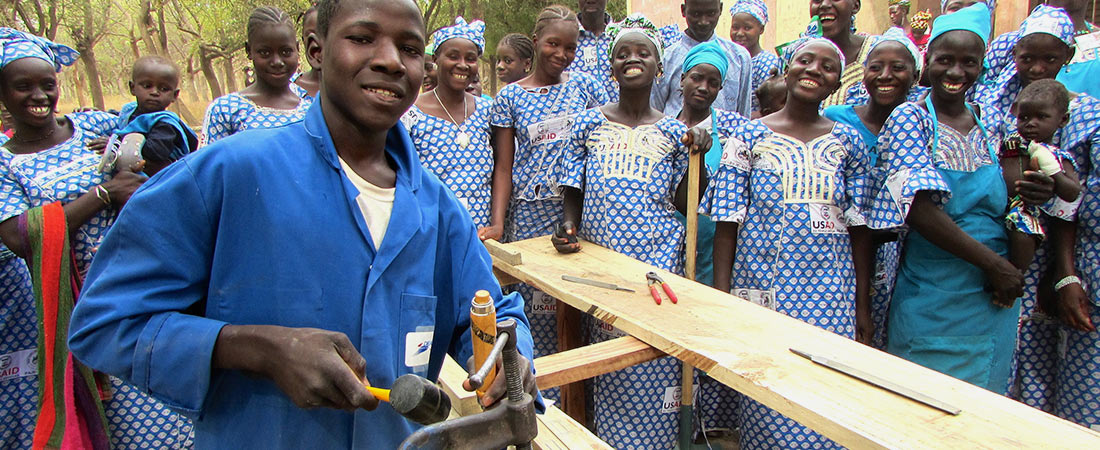5 Ways to Build Better Youth Development Programs

Participants of PAJE-Nièta in Mali.
Around the world, tens of thousands of young people face barriers to education and livelihoods, especially those living in low-resource communities that have high unemployment and a history of conflict.
Many of these young people have been able to acquire the tools, knowledge, and skills to build better lives for themselves and their families by participating in youth development programs such as EDC’s Yes Youth Can! North Eastern Region (YYC NER) in Kenya and the Mali Out-of-School Youth project (also known as PAJE-Nièta). During the past decade, these projects have shown that it is possible to build successful youth development programs even in the most challenging and conflict-affected environments.
So, what can other international development experts learn from these two successes? EDC’s Christopher Ying and Adwoa Atta-Krah draw upon their experiences in Kenya and Mali to offer five tips about building programs that work.
1. Let youth lead
In North East Kenya, where approximately 90 percent of youth are unemployed, YYC NER worked to increase youth participation through the creation of local civic groups, called bunges. Each bunge created its own constitution, developed its own work plan, and had a core leadership team of local youth.
“We connected them with other youth, we gave them new skills and knowledge, and we gave them the opportunity to do something different with their lives,” says Ying.
Youth were also heavily involved in PAJE-Nièta. University-educated youth volunteers worked with local project participants, leading basic education and entrepreneurship courses and assisting youth in launching their own microenterprises.
“These youth volunteers were really the frontline implementing agents of the PAJE-Nièta project,” says Atta-Krah.
2. Include women
Gender equity was built into the design of the Kenya program. At the local, county, and subcounty levels, each bunge had leadership positions reserved for female youth. Bringing women into the bunges helped give them a voice–previously absent—in community decisions.
Recruiting women to participate had the added benefit of broadening the base of people who could continue the work of the bunges after YYC NER had ended.
“Our project staff served as role models,” says Ying. “Most of the YYC NER staff were women. This provided youth with broad examples of how women could participate in and drive the program.”
3. Integrate entrepreneurship and education
For a youth development project to be effective, it has to meet youths’ educational and economic needs—that is basic education and entrepreneurship activities must be integrated. Atta-Krah says she learned this lesson after examining why youth drop-out rates from PAJE-Nièta trainings were so high during the first two years.
“It became evident that basic education training, on its own, wasn’t enough,” she says. “To keep youth motivated, programs should introduce youth to tangible concepts and opportunities for earning a living—entrepreneurship—as soon as possible.”
In response, the project team modified the rollout of training programs to better link basic education and entrepreneurship in the second and third cohorts, and the drop-out rate plummeted. In all, the project trained over 10,000 youth.
4. Stay local
In Mali, an early assessment found that youth would prefer to stay in their villages if they could earn a living there—a finding that influenced the way the PAJE-Nièta program was developed.
Bringing professional technical trainers to the villages allowed better, closer training and monitoring of youth beneficiaries, while it maximized the amount of time the youth spent in their villages.
Atta-Krah also says that the program developed partnerships with existing local businesses—such as local entrepreneurs and microfinance institutions—to further help youth launch their microenterprises.
“In order to ensure buy-in, and in order to ensure that the youth maintained their interest in the project, we made sure all activities went through existing youth associations,” she says.
5. Build peace
Training more than 4,000 Malian youth on conflict resolution produced real, immediate results. According to Atta-Krah, one village chief credited PAJE-Nièta with helping his community confront “old and very deep” internal conflicts. And a U.S. government-funded study also found that the project’s civic and economic activities empowered youth and led to “reduced vulnerability to radical narratives and the lure of extremist recruitment.”
While in Kenya, YYC NER delivered radio programming promoting peace and reconciliation, reaching over 1 million youth. But Ying believes that most of the peace-building was accomplished through the bunges, which fostered democratic ideals and brought together young people from different clans.
“The bunges allowed many young people to have a voice in their community for the first time,” says Ying. “That civic engagement is incredibly powerful for them—and for society.”